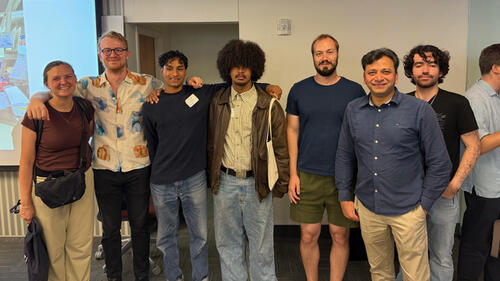
This summer, the Wright Lab Relativistic Heavy Ion Group (RHIG) hosted two local New Haven high school students from the Yale Pathways Summer Research Internship Program (YPRI). YPRI connects qualified public high school students from the New Haven area with scientific research labs at Yale for a seven-week summer internship. The program concluded on August 15 with a final symposium where each student presented their summer research project.
Vikram Dalal, from Wilbur Cross Comprehensive High School, was mentored by postdoctoral associate Isaac Mooney on “Measuring the Impact of Imperfections on Scintillating Tile Output for LFHCal at ePIC”. The project focused on characterization of the light yields of scintillating tiles, which are a key component in the longitudinal forward hadronic calorimeter (LFHCal) of the ePIC experiment at the future Electron-Ion Collider.
Dalal was able to determine, for the first time, that the light yield was reduced by about 6% for tiles that had defects due to manufacturing, storage, and/or transit. This result informs the LFHCal production and testing requirements in order to achieve relative uniformity of tile light yields throughout the hundreds of thousands of tiles that are necessary for the overall detector.
Mooney said, “Vikram learned quite a lot in a short amount of time, including programming languages, materials science and engineering principles, and particle and nuclear physics concepts. He was able to apply his understanding to the problem he was presented with to successfully obtain a final result.”
Mooney continued, “I was always impressed at his desire to be in the lab taking more data for analysis, as well as his resilience when (inevitably in research) something went wrong. And he and Omare kept the atmosphere fun, while still being serious about their work.”
Omare Goodson, from Hill Regional Career High School, was mentored by postdoctoral associate Zoltán Varga on “Optical setup for HRPPD of the ePIC detector”. Goodson developed and tested an optical setup for the High-Rate Picosecond Photodetector (HRPPD) to be used for the pfRICH detector at ePIC, measuring key parameters such as lens focusing, beam splitting ratio, photon losses, and quantum efficiency.
Varga said, “Omare’s research project involved learning many complex physics concepts, but Omare picked them up very quickly and was able to apply them effectively while performing the measurements. His dedication and enthusiasm were evident in how he exceeded expectations.”
Varga continued, “Omare also took on two side projects. He taught himself AutoCAD to design and 3D-print casings for muon detectors (which he also tested), and he improved a Van de Graaff generator used for demonstrations by integrating a DC motor with custom 3D-printed components.”
RHIG assistant professor Laura Havener said, “Both students did an excellent job and made important contributions to the various hardware work in the lab.” Havener continued, “And Zoltan and Isaac’s mentorship was crucial to the students’ success.”
During their internship, Dalal and Goodson were also invited to take part in the 2025 Summer Student Research Program at Wright Lab, which provided technical and professional development training workshops and enrichment activities.
This story was adapted from the Wright Lab news story of August 22, 2025, by Victoria Misenti.